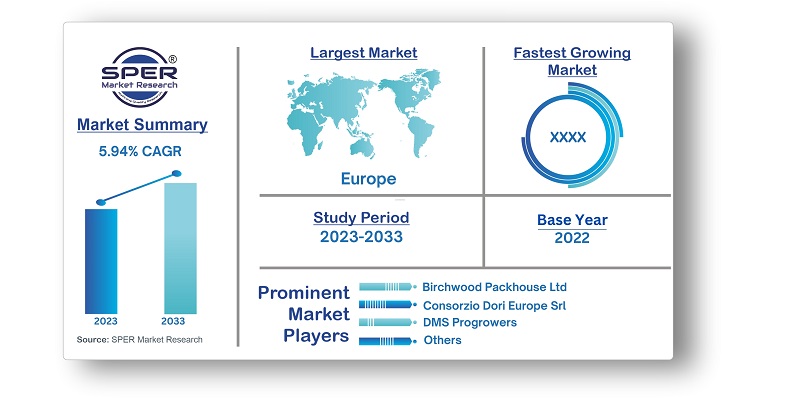
Europe Kiwi Fruit Market Growth, Size, Trends, Revenue, Demand, Challenges and Future Outlook
Europe Kiwi Fruit Market Size- By Consumption, By Application, By Distribution Channel- Regional Outlook, Competitive Strategies and Segment Forecast to 2033
| Published: Sep-2023 | Report ID: FOOD2380 | Pages: 1 - 152 | Formats*: |
| Category : Food & Beverages | |||
- In April 2022, Zespri stated that its red kiwifruit would be renamed Zespri RubyRed kiwifruit for the first year of commercial sales in the 2022 season. Because of its crimson pulp and berry flavor, this new variety will have a significant market opportunity in Asian countries.
- June 2021: Portugal's fruit production is insufficient to fulfill rising domestic and international demand. As a result, it intends to raise investment in fruit exports in order to improve efficiency and attract foreign investors in the country's agricultural.


| Report Metric | Details |
| Market size available for years | 2019-2033 |
| Base year considered | 2022 |
| Forecast period | 2023-2033 |
| Segments covered | By Consumption, By Application, By Distribution Channel |
| Regions covered | United Kingdom, France, Germany, Italy, Russia, Rest of Europe |
| Companies Covered | Birchwood Packhouse Ltd, Consorzio Dori Europe Srl, DMS Progrowers, Fresh Fruits Co, Kiwi Produce Ltd, Kiwifruit Processing Co. Ltd, Mount Pack and Cool, Zespri, Others |
- Restaurants and Food Service Providers
- Retailers
- Importers and Distributors
- Health and Wellness Enthusiasts
- Consumers
| By Consumption: |
|
| By Application: |
|
| By Distribution Channel: |
|
- Europe Kiwi Fruit Market Size (FY’2023-FY’2033)
- Overview of Europe Kiwi Fruit Market
- Segmentation of Europe Kiwi Fruit Market By Consumption (Direct Consumption, Juice, Jams, Sauce, Ice Cream, others)
- Segmentation of Europe Kiwi Fruit Market By Application (Food & Beverages, Dietary Supplements)
- Segmentation of Europe Kiwi Fruit Market By Distribution Channel (Supermarkets & Hypermarkets, Online)
- Statistical Snap of Europe Kiwi Fruit Market
- Expansion Analysis of Europe Kiwi Fruit Market
- Problems and Obstacles in Europe Kiwi Fruit Market
- Competitive Landscape in the Europe Kiwi Fruit Market
- Impact of COVID-19 and Demonetization on Europe Kiwi Fruit Market
- Details on Current Investment in Europe Kiwi Fruit Market
- Competitive Analysis of Europe Kiwi Fruit Market
- Prominent Players in the Europe Kiwi Fruit Market
- SWOT Analysis of Europe Kiwi Fruit Market
- Europe Kiwi Fruit Market Future Outlook and Projections (FY’2023-FY’2033)
- Recommendations from Analyst
1.1. Scope of the report1.2. Market segment analysis
2.1. Research data source2.1.1. Secondary Data2.1.2. Primary Data2.1.3. SPER’s internal database2.1.4. Premium insight from KOL’s2.2. Market size estimation2.2.1. Top-down and Bottom-up approach2.3. Data triangulation
4.1. Driver, Restraint, Opportunity and Challenges analysis4.1.1. Drivers4.1.2. Restraints4.1.3. Opportunities4.1.4. Challenges4.2. COVID-19 Impacts of the Europe Kiwi Fruit Market
5.1. SWOT Analysis5.1.1. Strengths5.1.2. Weaknesses5.1.3. Opportunities5.1.4. Threats5.2. PESTEL Analysis5.2.1. Political Landscape5.2.2. Economic Landscape5.2.3. Social Landscape5.2.4. Technological Landscape5.2.5. Environmental Landscape5.2.6. Legal Landscape5.3. PORTER’s Five Forces5.3.1. Bargaining power of suppliers5.3.2. Bargaining power of buyers5.3.3. Threat of Substitute5.3.4. Threat of new entrant5.3.5. Competitive rivalry5.4. Heat Map Analysis
6.1. Europe Kiwi Fruit Market Manufacturing Base Distribution, Sales Area, Product Type6.2. Mergers & Acquisitions, Partnerships, Product Launch, and Collaboration in Europe Kiwi Fruit Market
7.1. Europe Kiwi Fruit Market Value Share and Forecast, By Consumption, 2023-20337.2. Direct Consumption7.3. Juice7.4. Jams7.5. Sauce7.6. Ice Cream7.7. Others
8.1. Europe Kiwi Fruit Market Value Share and Forecast, By Application, 2023-20338.2. Food & Beverages ( Bakery, Confectionary, Sauces, Beverages)8.3. Dietary Supplements
9.1. Europe Kiwi Fruit Market Value Share and Forecast, By Distribution Channel, 2023-20339.2. Supermarkets & Hypermarkets9.3. Online
10.1. Europe Kiwi Fruit Market Size and Market Share
11.1. Europe Kiwi Fruit Market Size and Market Share By Consumption (2019-2026)11.2. Europe Kiwi Fruit Market Size and Market Share By Consumption (2027-2033)
12.1. Europe Kiwi Fruit Market Size and Market Share By Application (2019-2026)12.2. Europe Kiwi Fruit Market Size and Market Share By Application (2027-2033)
13.1. Europe Kiwi Fruit Market Size and Market Share By Distribution Channel (2019-2026)13.2. Europe Kiwi Fruit Market Size and Market Share By Distribution Channel (2027-2033)
14.1. Europe Kiwi Fruit Market Size and Market Share By Region (2019-2026)14.2. Europe Kiwi Fruit Market Size and Market Share By Region (2027-2033)14.3. United Kingdom14.4. France14.5. Germany14.6. Italy14.7. Russia14.8. Rest of Europe
15.1. Birchwood Packhouse Ltd.15.1.1. Company details15.1.2. Financial outlook15.1.3. Product summary15.1.4. Recent developments15.2. Consorzio Dori Europe Srl15.2.1. Company details15.2.2. Financial outlook15.2.3. Product summary15.2.4. Recent developments15.3. DMS Progrowers15.3.1. Company details15.3.2. Financial outlook15.3.3. Product summary15.3.4. Recent developments15.4. Fresh Fruits Co.15.4.1. Company details15.4.2. Financial outlook15.4.3. Product summary15.4.4. Recent developments15.5. Kiwi Produce Ltd.15.5.1. Company details15.5.2. Financial outlook15.5.3. Product summary15.5.4. Recent developments15.6. Kiwifruit Processing Co. Ltd.15.6.1. Company details15.6.2. Financial outlook15.6.3. Product summary15.6.4. Recent developments15.7. Mount Pack and Cool15.7.1. Company details15.7.2. Financial outlook15.7.3. Product summary15.7.4. Recent developments15.8. Zespri15.8.1. Company details15.8.2. Financial outlook15.8.3. Product summary15.8.4. Recent developments15.9. Others
SPER Market Research’s methodology uses great emphasis on primary research to ensure that the market intelligence insights are up to date, reliable and accurate. Primary interviews are done with players involved in each phase of a supply chain to analyze the market forecasting. The secondary research method is used to help you fully understand how the future markets and the spending patterns look likes.
The report is based on in-depth qualitative and quantitative analysis of the Product Market. The quantitative analysis involves the application of various projection and sampling techniques. The qualitative analysis involves primary interviews, surveys, and vendor briefings. The data gathered as a result of these processes are validated through experts opinion. Our research methodology entails an ideal mixture of primary and secondary initiatives.



Frequently Asked Questions About This Report
PLACE AN ORDER
Year End Discount
Sample Report
Pre-Purchase Inquiry
NEED CUSTOMIZATION?
Request CustomizationCALL OR EMAIL US
100% Secure Payment






Related Reports
Our Global Clients
Our data-driven insights have influenced the strategy of 200+ reputed companies across the globe.




















